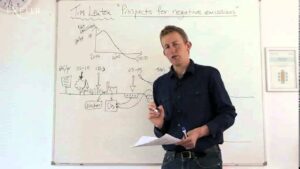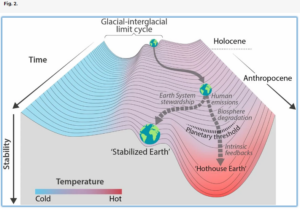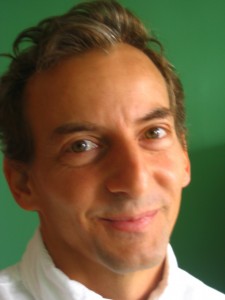The latest and best overview of climate feedbacks is out. UK scientist Tim Lenton reports possible futures. From New York, author and activist Andrew Boyd on his new book “I Want A Better Catastrophe.”
Listen to or download this Radio Ecoshock show in CD Quality (57 MB) or Lo-Fi (14 MB)
Professor TIM LENTON
“Many risky feedback loops amplify the need for climate action”
Both China and India are increasing coal burning. Oil and gas companies never made so much money. We know what is going to happen. Except we don’t. Even with stunning climate science, global models, and summary reports, we could be flying blind into unexpected catastrophes. A group of leading climate scientists warn “Many risky feedback loops amplify the need for climate action”. They have a list of 60 forces – physical, biologic, and human – all bouncing into our times, feeding back into a destabilized climate.
Here to explain is one of our favorite British scientists, Professor Tim Lenton, Director of the Global Systems Institute at the University of Exeter. Tim is a co-author of the new paper, along with Bill Ripple from Oregon, and two of my heroes Johan Rockström of the Stockholm Resilience Centre, and Hans Joachim Schellnhuber, founding director of the Potsdam Institute for Climate Impact Research (PIK). Schellnhuber was science adviser to former German Chancellor Angela Merkel. These are senior climate scientists and they are worried.

Listen to or download this 31 minute interview with Tim Lenton in CD Quality or Lo-Fi
This paper begins with a short-list of nine big physical feedback mechanisms. Most of us have heard of things like sea ice melt, permafrost thaw, desertification and deforestation. There are two common themes running though them. One is about sequestration, where carbon previously stored in plants and the earth is released to the atmosphere, and not recaptured by the carbon cycle. The other is change in albedo, the amount of the Sun’s energy reflected back into space.
At first, I thought the role of biological life changing climate has been left out. Not at all. The authors add 21 feedback mechanisms possible from the reactions of plants and animals to changing conditions. I ask Tim: Are these biological feedbacks minor compared the big physical systems like ocean currents or sea ice decline?
I felt the paper could have done more with two biological drivers: plankton and bacteria. There is one note about plankton, and the word “bacteria” does not appear in this paper. “Microbial activity” is listed as positive, raising emissions of that other greenhouse gas, nitrous oxide. Still, we know very little about how the world’s largest mass of living matter, microscopic life, will react to warming, and the size of that impact.
The master list of 61 feedbacks (!) includes seven that are negative. These should cool the planet, or at least slow down warming. But it appears they are not strong enough to counter-act our warming.
WILL CLOUDS DAMPEN WARMING OR SPEED IT UP?
You really should listen to this one. It’s loaded with key points and insights. For example, the role of clouds during climate change is still not known. Will they add to heating or slow it down?
Clouds contain ice particles. Energy absorbed into melting that ice doesn’t reach the surface, and water droplets reflect more sunlight back into space. But how much ice is up there, particularly in clouds over the massive great Southern Ocean? Very recent science has shed some light. Using satellite measurements, it turns out clouds have a lower ice content than previously thought. So their dampening effect on warming would be less that some models have assumed. That sounds small, until multiplied over large portions of the Earth’s atmosphere, where the total effect can be very large.
In our interview, Lenton says:
“That means that when the world warms up you can quite rapidly max out or switch off that feedback and stop it’s standing effect. That turns out to be really important because without that feedback you get much more warming for any given change in greenhouse gas levels.”
AND…
“If we double the carbon dioxide level in the atmosphere [to 560 ppm] we would have expected about 1.2 degrees Centigrade of warming, whereas including the feedbacks we know about we expect that number to be more like 3 degrees C. on a century timescale, and could be as much as 6 degrees C on the long, the millennial time scale. But crucially it’s not at the point where it will go into runaway and just be self-propelling warming which is the hothouse scenario.”
AND WE ARE HEATING UP THIS CENTURY…
In our interview, Lenton says:
“Unfortunately current policies, such as they are, are still taking us into a world that’s going to be at least 2.5 degrees C warmer in the second half of this century – and depending on these feedbacks, could be quite a bit warmer than that.”
MORE NOTES FROM ALEX
In 2018 three of these authors published the classic paper “Trajectories of the Earth System in the Anthropocene”. It is one of the most downloaded papers in science. Figure 2 showed a possible shelf, called “Stabilized Earth”, much safer than warming all the way to “Hothouse Earth”. Since then, humans have only increased greenhouse gas emissions even more, this year cresting 3.5 parts per million added.

Given the 27 positive feedbacks many with tipping points possibly nearby in time, is an alternative to Hothouse Earth still possible? Lenton says “yes” – several alternatives still remain viable. In fact, he says so far the forces driving warming are not enough to drive Earth into a self-perpetuating warming directly to Hothouse Earth. Scientists Kevin Trenberth and Michael Mann suggest buffering by the global ocean is powerful enough to contain further warming, including feedback effects, once humans stop adding more greenhouse gases. Of course, if major feedback loops start to interact, to “cascade” – we don’t know…
In this whole important paper, I found one sentence where I disagree. The authors write:
“…the accuracy of climate models is of vital importance since they guide climate mitigation efforts by informing policymakers about the expected effects of anthropogenic emissions.”
Reality shows climate models are not guiding climate mitigation efforts. “Policymakers” are not mitigating anything about emissions or human expansion into the rest of the natural world. All that is increasing. Plans for even more carbon pollution and abuse have been approved and funded. Sometimes academics are over-optimistic about the role of science. And yet this is one foot in the door, which has led to at least some positive moves, Lenton says, citing recent U.S. climate-oriented legislation.
The study’s opening list of 15 human feedbacks on climate change hits most possibilities. But I think the category “human conflict” needs to explicitly include thermonuclear war, as a special climate feedback. Scientists say an exchange of nuclear weapons could lead to large-scale initial cooling due to dust blotting out the sun for several years. This change could take place in a matter of days, at any time. I could not find the word “nuclear” or “atomic” in this new paper… something to add?
This group of scientists is most known for high-level climate work. They are not activists. Yet this new paper concludes we needs transformative change to almost every aspect of human life, starting with the energy industry but going on to population policies, education, and equality. It’s a big order. I ask Tim: Why now, why the urgency?
The new paper is “Many risky feedback loops amplify the need for climate action”. It was published in the journal One Earth on February 17, 2023. It is free to read or download. You should.
=========================================
ANDREW BOYD: I WANT A BETTER CATASTROPHE
OK. We are doomed. The atmosphere and now the weather has gone off the rails. The pandemic is “over” and thousands of people still die every week. The stock market is shaky… need I go on? If you know all that, what now? Long-time activist, prankster and culture jammer Andrew Boyd has a few ideas. His latest book is out. It is called “I Want a Better Catastrophe: Navigating the Climate Crisis with Grief, Hope, and Gallows Humor”.

Listen to or download this 26 minute interview with Andrew Boyd in CD Quality or Lo-Fi
We begin by discussing some of the tools Boyd has helped create with other activists. He explains how “Climate Ribbons” help build community, by sharing climate fears and committing to protect what other hold most dear. Boyd is also Chief Existential Officer of something called Climate Clock. One of his earlier pranks, which gained national attention, was “Billionaires for Bush”.
Billionaires for Bush became a book “How to Rule the World for Fun and Profit” – with advice on purchasing a president, landing a trophy wife, and buying governments. That was 2004. Sadly, all that came to pass in recent years of U.S. politics. But Andrew Boyd moved on to climate change. His earlier books are ““Daily Afflictions: The Agony of Being Connected to Everything in the Universe”, and “Life’s Little Deconstruction Book: Self-Help for the Post-Hip.”
On the Climate Clock web site (check it out!) you find this quote from Greta Thunberg:
“If your stories do not include the notion of a ticking clock, then the climate crisis is just a political topic among other topics, something we can just buy, build or invest our way out of. Leave out the aspect of time and we can continue pretty much like today and “solve the problems” later on. 2030, 2050 or 2060. The best available science shows that with our current rate of emissions, our remaining carbon budget for staying below 1.5°C will run out before the end of this decade.”
Source: An Open Letter to the Global Media by Greta Thunberg and Vanessa Nakate (29 Oct 2021) Time
This new book was a journey of exploration taking 8 years. In addition to Boyd’s own tortuous struggle to stay afloat as this civilization sinks, he went out and interviewed seven leading post-doom thinkers. I’m just going to list them here: Guy MacPherson, Tim DeChristopher, Meg Wheatley, Gopal Dayaneni, Joanna Macy, Jamey Hecht, Adrian Marie Brown, and Robin Wall Kimmerer. You find short interviews with each in the book.
I appreciate Boyd introducing me to Margaret Wheatley. Through her, I learned about aboriginal ways of passing knowledge and wisdom down through time with constructions called “Songlines”. In Australia, the original inhabitants used these to weave together a geography of their environment AND their dreams, all passed on with stories and symbols for thousands of years. In the current information clutter, I think we all need a little book with short lines to remember, when things collapse. Maybe you know a little deconstruction book like that?
Actually, let’s go back to Boyd’s “Life’s Little Deconstruction Book”
These koan-like lines contained a send-up of the wordy academic trends of post-modernism. E.g.
* Implicate yourself in every interpretation.
* Expose depth as another surface.
* Publicize your privates.
* Fashion reason.
* Reduce meaning to a hodge-podge of signifiers.
* Shop as though money were a consensual hallucination.
This reminds me of the techniques used during the Occupy Movement. They needed to transmit the words of speakers through a large crowd without any microphones. The speaker would give a sentence and stop. Those nearest repeated it in loud voices and all waited until the outer crowd heard it too.
Suppose we do that over space and time. The wisest among us assemble short phrases, green mantras if you will, to pass on. Memorization training also strengthens the brain.
Then as we live and decide, we have these saying to guide us. No corporate media or government approval is required. These saying may also map out the danger zones where chemicals or radioactive waste are lurking, something humans may need to remember for centuries, whether civilizations fall or not. Like the aboriginal people, they should also include some of our dreams, for living in peace with one another and all the species, even Natural things, like rivers, mountains, and honored trees.
“TWELVE CHARACTERS IN SEARCH OF AN APOCALYPSE”
A few working parts of Boyd’s “Better Apocalypse” book came out in Dark Mountain in 2017. For example, Boyd developed voices for “the twelve characters of the apocalypse”. These characters do read like characters speaking. We have probably met them when climate change comes up. I’ve used a few of those excuses myself trying to justify some of my own actions, burning some carbon because everybody else is, and that’s what we do to get on… “Twelve Characters in Search of an Apocalypse” became a performance which toured in England and Wales. Not all 12 characters made it into the book, and Andrew added another seven at one point. It’s worth going back to the Dark Mountain article.
Is 12 Characters a ‘performance’, a ‘workshop’, or something else?
And then there is “hope”. At least there was. Boyd spends a whole chapter, complete with a wall-sized flow chart, to find the remains of hope, and sort of justify it. Why all that angst? Can’t we go on to meaningful lives without hope?
Here is my problem. I have been documenting and interviewing experts who predicted “collapse” for the past 20 years or so. It’s like the Christians waiting for the Second Coming. The End of the World never comes. What if this crazy system just keeps falling over and getting up for hundreds of years, doing damage all the way down?
WE ARE ALL ESCAPE ARTISTS
Among the garden of wise quotes in this book, Boyd includes French philosopher Albert Camus saying
“I want to know whether I can live with what I know.”
That is so apt for climate times. I can only live with what I know for a few hours a day. The rest of the time I need to escape. We are all escape artists. We have to be. Even the most realistic climate scientist, calculating the years left, then watches stupid dramas on TV, plays video games, or collects something. Do we need to acknowledge escape in our strategy – like time outside in the yard when serving a life sentence in prison?
The Buddha is reputed so have said: “All the world is suffering – therefore rejoice.” David Crosby sang “Rejoice, rejoice, we have no choice, but to carry on.” I’m hearing that in this book by Boyd: how to be happy in horrible times.
Even the titles of each book segment read like little Japanese koans… things like:
“You don’t need to ‘save the world’; it’s already made other plans,”
Or: “Your job at the end of the world is to become a happier person.”
THE KINGSNORTH PROBLEM
Boyd asks tough questions, like “What are we supposed to campaign for?” What should we tell people, like – and I quote from this book: “Do you say: ‘Wanna sign this petition to wreck the planet in 100 years instead of 50?’ Or: ‘Hey, neighbor, I’m here today seeking beauty and dignity in failing to stop the inevitable. Care to pitch in?’ Or: ‘My group is learning how to die as a civilization, wanna join?’” OK, funny, but not funny. How can we communicate?
We had Paul Kingsnorth on Radio Ecoshock early on. Boyd’s book quotes Paul’s list of time-wasters, like political reform, eco-terrorism, romanticizing hunter-gathering, new tech, and most of what passes for environmental advocacy. But then Boyd passes on Kingsnorth’s five things that are not a waste of time. They are:
withdrawing, preserving non-human life, getting your hands dirty, insisting nature has intrinsic value, and building refuges.
You can watch a YouTube interview with Andrew Boyd here (6 minutes)
=====================================
OVER AND OUT
I end my one hour program with a quick quote from famous civil rights author James Baldwin, as found in Andrew Boyd’s new book.
“I can’t be a pessimist because I am alive.
To be a pessimist means that you have agreed that human life is an academic matter.
So, I am forced to be an optimist. I am forced to believe that we can survive, whatever we must survive.”
– James Baldwin, I Am Not Your Negro
My sincere thanks to listeners who send me $10 a month to pay the costs of producing and distributing Radio Ecoshock to anyone, world-wide, absolutely free. You make it possible.
NEXT WEEK
Next week, we talk with Thomas Homer-Dixon, author of “The Upside of Down” and “The Ingenuity Gap” – plus his latest book “Commanding Hope.” This is a gritty realism from a top long-time security expert with a glimmer, just a glimmer, young people can hold on to. We still have a chance.
Then from Rotterdam, Yogi Hendlin on trying to handle fossil fuel apologists all around us. A sardonic look at the empire of excuses. Please join me again next week.
I’m Alex Smith. Thank you for listening, and caring about our world.
Pingback: Nuclear news this week – as we remember Fukushima | Nuclear Australia
Pingback: Aside from – Zodiacal Spiral